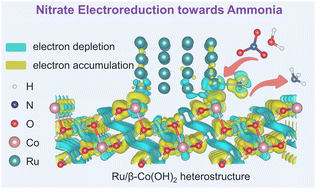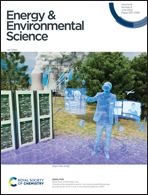Weakened d–p orbital hybridization in in situ reconstructed Ru/β-Co(OH)2 heterointerfaces for accelerated ammonia electrosynthesis from nitrates†
Abstract
The electrocatalytic nitrate reduction reaction (NtrRR) has recently become an emerging technology that can convert nitrate pollutants into high-value added ammonia products in a mild manner. However, it is highly challenging to develop NtrRR electrocatalysts with high activity, selectivity, and stability given the sluggish kinetics and diverse pathways of the NtrRR. Herein, we develop a Ru/β-Co(OH)2 heterostructure catalyst derived from in situ reconstruction of Ru-doped Co metal nanosheets with an ultralow Ru/Co ratio of 3.08 at%. The synergy and strong interactions between interfacial Ru and Co sites weaken the d–p orbital hybridization ability with *NH3 intermediates, which thus lowers the barrier of the potential determining step. As a result, the catalyst delivers an industrial-level current density of −500 mA cm−2 at a positive potential of only 0.01 V vs. the reversible hydrogen electrode, along with a high ammonia Faradaic efficiency of 98.78%. Meanwhile, it can purify the nitrate sewage and reduce the nitrate concentration to 13–31 ppm. Furthermore, the assembled Zn-nitrate flow battery also delivers a decent power density of 29.87 mW cm−2 and a high ammonia yield of up to 0.38 mmol h−1 cm−2 with excellent stability. This work suggests an effective strategy for designing high-performance electrocatalysts through interface engineering by rational reconstruction.



 Please wait while we load your content...
Please wait while we load your content...